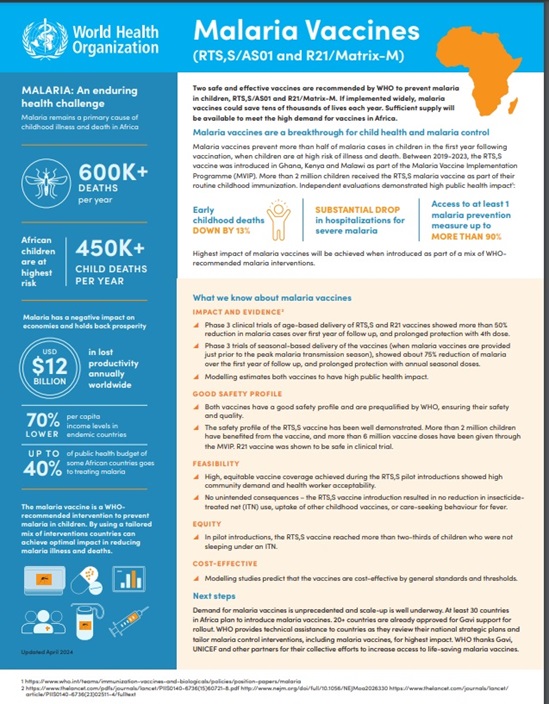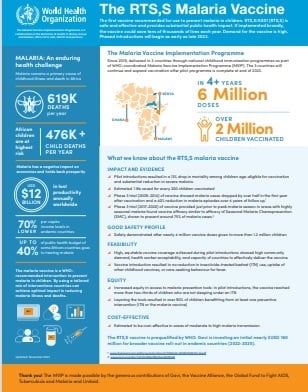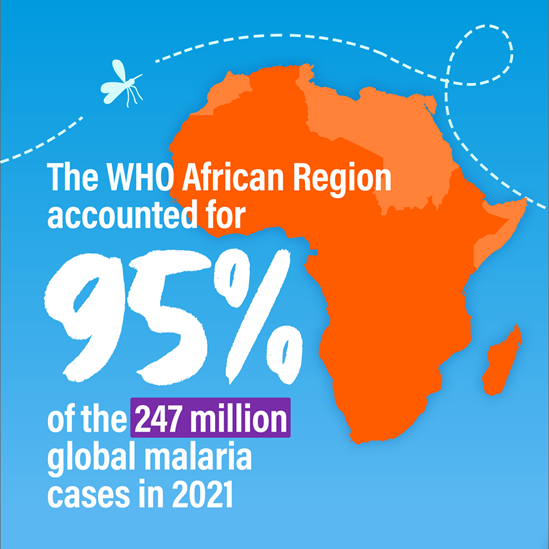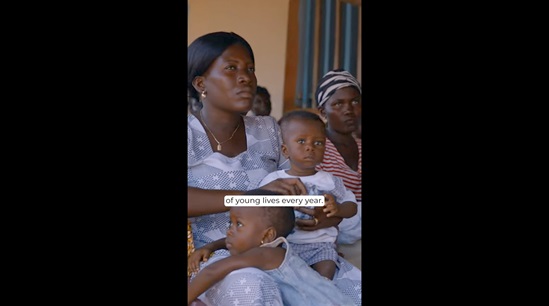A woman walks with her child in the village of Kingombe, near Kalemie, in the Democratic Republic of the Congo.
Malaria
Malaria is a life-threatening disease caused by parasites that are transmitted to people through the bites of infected female Anopheles mosquitoes. It is preventable and curable. There are 5 parasite species that cause malaria in humans, and 2 of these species – Plasmodium falciparum and Plasmodium vivax – pose the greatest threat.
In 2022, nearly half of the world's population was at risk of malaria. While sub-Saharan Africa carries a disproportionately high share of the global malaria burden, the WHO regions of South-East Asia, Eastern Mediterranean, Western Pacific, and the Americas also report significant numbers of cases and deaths.
There were an estimated 249 million cases of malaria in 2022, and the estimated number of malaria deaths stood at 608 000. In 2022, the African Region was home to 94% and 95% of malaria cases and deaths, respectively.
Children under 5 years of age are the most vulnerable group affected by malaria; in 2022, they accounted for nearly 80% of all malaria deaths in the WHO African Region.
Malaria is an acute febrile illness. In a non-immune individual, symptoms usually appear 10–15 days after the infective mosquito bite. The first symptoms – fever, headache, and chills – may be mild and difficult to recognize as malaria. If not treated within 24 hours, Plasmodium falciparum malaria can progress to severe illness, and lead to death.
Children with severe malaria frequently develop one or more of the following symptoms: severe anaemia, respiratory distress in relation to metabolic acidosis, or cerebral malaria. In adults, multi-organ failure is also frequent. In malaria endemic areas, people may develop partial immunity, allowing asymptomatic infections to occur.
Some population groups are at considerably higher risk of contracting malaria, and developing severe disease, than others. These include infants, children under 5 years of age, pregnant women and patients with HIV/AIDS, as well as non-immune migrants, mobile populations and travellers. National malaria control programmes need to take special measures to protect these population groups from malaria infection, taking into consideration their specific circumstances.
Malaria is a preventable and treatable disease. Early diagnosis and treatment of malaria reduces disease and prevents deaths, and also contributes to reducing transmission. The best available treatment, particularly for Plasmodium falciparum malaria, is artemisinin-based combination therapy (ACT). Antimalarial medicines can also be used to prevent malaria.
For travellers, malaria can be prevented through chemoprophylaxis, which suppresses the blood stage of malaria infections, thereby preventing malaria disease. Prior to their travel to malaria-endemic countries or regions, individuals should consult their national disease control centres, or other institutions offering travel advice, for information regarding the preventive measures that should be taken.
See also the WHO International travel and health
WHO recommends protection for all people at risk of malaria with effective malaria vector control.

/in-page-highlights/malaria-health-topic.tmb-479v.jpg?sfvrsn=96ff861e_8)





/photostory/2023-india-chhattisgarh/malaria-india-chhattisgarh-panos-aloke-difficult-terrain.tmb-549v.jpg?sfvrsn=43ace47f_1)



/malaria-conference-stakeholders-video.tmb-549v.jpg?sfvrsn=f7db694c_2)
/malaria-conference-tedros-video.tmb-549v.png?sfvrsn=12a338f7_1)
/malaria-conference-ghetto-kids-video.tmb-549v.png?sfvrsn=9a711277_2)
